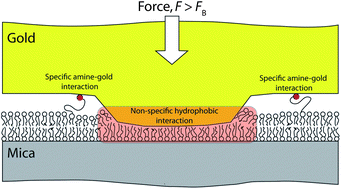Non-specific physical and specific chemical interactions of cells, bacteria, and biomembranes with non-biological target surfaces (e.g., metallic and metal oxides) are crucial in determining the interfacial behavior (interaction forces, adhesion, local deformations and structuring) of many bio- and nano-inspired materials. Knowledge of the governing interactions provides physicochemical understanding of biological systems, and enables engineering of new nano-systems for biomaterials or biomedical benefit. We have directly measured and visualized membrane adhesion and detachment at nanoscopic and extended rough gold electrode surfaces through a multi-scale approach: interactions and contact mechanics measured by surface forces apparatus (SFA) are in quantitative agreement with atomic force microscopy (AFM) measurements, both of which show that membranes can strongly adhere to rough gold surfaces and asperities via specific amine–gold binding and non-specific hydrophobic interactions. The results give insights into membrane interactions at smooth and rough metallic surfaces, and provide a basis for improved design of nanoparticle and extended surface biomaterials.

You have access to this article
 Please wait while we load your content...
Something went wrong. Try again?
Please wait while we load your content...
Something went wrong. Try again?


 Please wait while we load your content...
Please wait while we load your content...